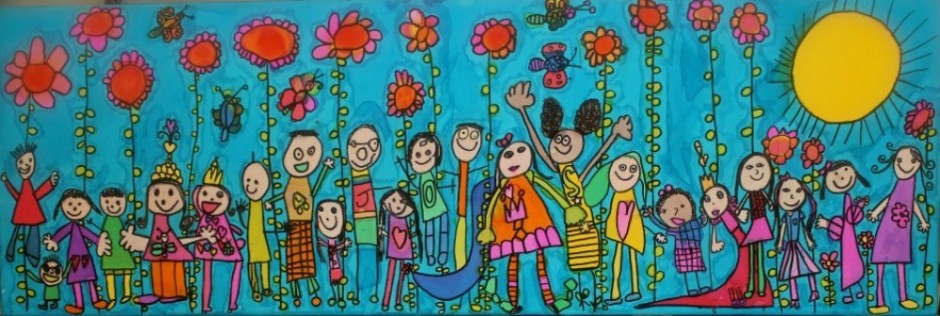Children are Infinitely Capable
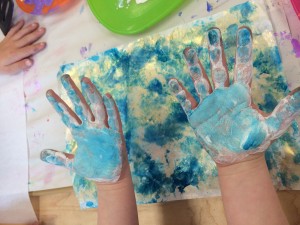
My students getting creative and exploring colour and texture with making collage paper for our Eric Carle Butterfly project
By their very nature, children are naturally inquisitive and desire to discover the world through exploration, imagination, and collaboration. I believe that children are born capable of learning and becoming competent in communicating through a variety of modalities. My teaching philosophy stems from the enriched teaching concepts of the Reggio Emilia approach, developed by Loris Mallaguzzi. I believe in Mallaguzzi’s statement that as teachers “our task is to help children communicate with the world using all their potential, strengths, and languages, and to overcome any obstacle presented by our culture”. I also support Mallaguzzi’s beliefs that “each child is…infinitely capable, creative, and intelligent” and that “the job of the teacher is to support these qualities and to challenge children in appropriate ways”. In order to fulfill my role as a teacher, I aspire to embody the role of observer, facilitator, researcher, and guide for the students in my care. My philosophy incorporates my belief that it is our duty to ensure every child feels they are a worthy contributor to the class. The themes expressed within my philosophy include a positive classroom climate, hands-on, experiential engagement, and inquiry and arts-based learning.
Fostering a Caring and Safe Classroom

I stand beside my students through their experiences as a trustworthy, caring and approachable role model
In order for me to be successful in this mission it is necessary for me to create a positive classroom environment that is safe, comfortable, and conducive to student development (emotionally, intellectually, physically and socially). I feel this requires me to consistently educate myself on techniques that can aid me in not only understanding my students’ individual differences but also incorporating new techniques that support my students’ learning differences and social needs. As a teacher, I am committed to creating a classroom environment that goes beyond classroom management and builds what Noddings describes as an “atmosphere of care and trust” (Noddings, 2006). As Noddings states, this environment “provides children the opportunity to talk about moral questions and to achieve understanding of self, peers, and the community at large” (Noddings, 2006). Through my experience with inquiry-based learning this supportive and safe environment can be achieved by learning and teaching alongside my students, while greatly valuing their opinions and presence in the class. Thus, I believe that the learning environment should be social, active, respectful, and explorative.
Collaboration with Students
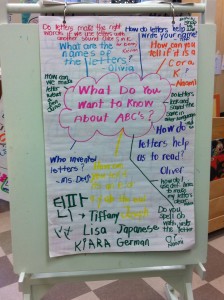
One of the many brainstorming sessions implemented in the classroom – students took part in the development of themes and lessons by sharing their interests, ideas, questions and wonders about the world.
My goal as a teacher is to provide students with an engaging environment that encourages deeper thinking, for I believe this will allow children to “develop the inner motivation to learn [as] teachers [give them] the freedom to construct knowledge from their own investigations” (Fraser, 2000). I believe that the school atmosphere should be a place of shared experiences that encourages the development of relationships among both children and adults by establishing strong community connections. This sense of belonging needs to be created by collaborating with students, colleagues and parents. Through my practicum experience, I have found great success in ensuring that each of my students feel they have a valued voice by providing the opportunity for contribution to class discussions through engagement in daily meetings and involving students in the development of classroom rules and lesson themes. An example of this is collaborating 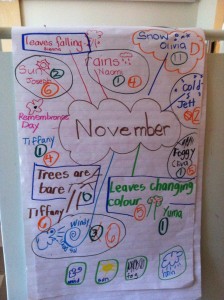 with students on creating the monthly calendar pattern by engaging students in a brainstorm of themes they see relating to the particular month, deciding as a whole class on the pattern and including the students in creating the pattern squares. When planning any classroom parties the students where involved in deciding the type of activities and games they would like to play, how they would like the class to be decorated, and students would choose job tasks to take part in the creation and set up of the party. I seek out to dismiss authoritative teaching where the students’ rights to be involved in their learning are respected.
with students on creating the monthly calendar pattern by engaging students in a brainstorm of themes they see relating to the particular month, deciding as a whole class on the pattern and including the students in creating the pattern squares. When planning any classroom parties the students where involved in deciding the type of activities and games they would like to play, how they would like the class to be decorated, and students would choose job tasks to take part in the creation and set up of the party. I seek out to dismiss authoritative teaching where the students’ rights to be involved in their learning are respected.
Social Emotional Learning
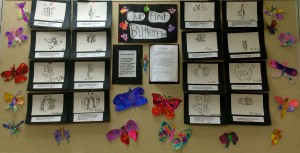
Documentation displayed in my class of the process students went through while learning about butterflies. This wall includes students first drawings of their perceptions of what a butterfly looks like, their second drawings after observing butterfly specimens, their documented thoughts about their drawings and their final Eric Carle collage butterflies. Included is a note to parents describing the student’s learning processes.
Throughout my teaching career I plan on fostering social emotional learning (SEL) within my classrooms through making strong connections with my students, understanding their various ways of expressing information, and supporting an inclusive environment. I believe that when incorporating SEL into a classroom CASEL’s five core competencies of self-awareness, self-management, social awareness, relationship skills, and responsible decision making skills need to be promoted to encourage positive attitudes of school, self, and others (CASEL, 2013). I aim to promote an environment that encourages positive emotional responses by creating a classroom setting that is aesthetically pleasing and which fosters artistic expression. The physical space not only invites children to analyze a variety of perspectives but also encourages parents to engage with the life of the classroom (Fiore, 2012). The classroom environment can greatly affect the students’ moods, social interactions and level of engagement. It is my mission to display documentation of students’ work to allow students to appreciate each other’s work and acknowledge their own capabilities. My teaching philosophy reinforces the belief that assessment and documentation should become a tool for gaining insight into each child’s intellectual abilities and as resource material to help modify my teaching strategies to best support the progress of my students.
Supporting Students through Life’s Challenges
Connected with classroom environment is the ability of the teacher and the students to prevent and solve problems. It is my goal to work towards improving and developing proper techniques for self-expression, self-regulation, and problem solving methods within my classrooms. This requires that I engage in professional development and reflective practices, and gain support and mentorship through colleagues in the profession. Through research I have begun to develop a strong foundation of developing a respectful and positive learning environment. A few strategies I found useful in my practicum were encouraging “I statements”, and role-playing with alternative outcomes of a situation.
Encouraging Self Expression through the Arts
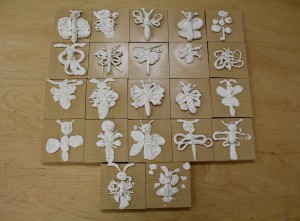
By taking note of the student’s interest in using play-dough during centres “magic clay” was used to reinforce students understandings of a butterfly’s body parts. Their unique sculptures were displayed in class.
My teaching philosophy has been inspired by my mentors in the teaching profession that successfully have incorporated a very arts based, inquiry driven style of teaching. I envision my classroom to be one that encourages children to express their understandings through drawing, sculpting, dramatic play, writing and painting. My reasoning stems from many educational articles including Grauer’s starting with Art, where he states, “Children seem to learn with more engagement when they have a chance to combine their understanding in art and language arts” (Grauer, 2001).
Resources:
CASEL: Collaborative for Academic, Social, and Emotional Learning. (2013). The Five Social and Emotional Learning Core Competencies. Retrieved from CASEL: Success in schools. Skills for life.: http://www.casel.org/social-and-emotional-learning/core-competencies
Edwards, C. P., Forman, G. E., & Gandini, L. (2012). The hundred languages of children: the Reggio Emilia experience in transformation. Santa Barbara, California, United States: Praegar.
Fiore, L. B. (2012). Assessment of Young Children: A Collaborative Approach. New York: Taylor & Francis.
Fraser, S. (2000). Authentic Childhood: Experiencing Reggio Emilia in the Classroom. Scarborough, Ontario, Canada: Nelson.
Grauer, K. (2011). Starting with Art: Relating Children’s Visual and Written Expression. In K. Grauer, R. Irwin, and M. Emme (Eds.), StARTing With . . ., Third Edition, Toronto, Ontario: Canadian Society for Education through Art.
Noddings, N. (2006). Handle with Care. Greater Good.
